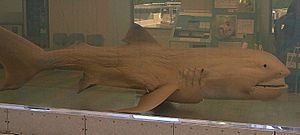Megamouth shark facts for kids
Quick facts for kids Megamouth shark |
|
|---|---|
 |
|
| A preserved specimen | |
| Conservation status | |
| Scientific classification | |
| Kingdom: | |
| Class: | |
| Subclass: | |
| Order: |
Lamniformes
|
| Family: |
Megachasmidae
|
| Genus: |
Megachasma
|
| Binomial name | |
| Megachasma pelagios |
|
 |
|
| Range of the Megamouth shark (in blue) | |
Imagine a huge, gentle shark that swims slowly and was only found by humans in 1976! That's the megamouth shark (Megachasma pelagios). This amazing creature can grow up to 5.5 meters (about 18 feet) long. You can find megamouth sharks in the warm waters of the Indian Ocean, Atlantic Ocean, and Pacific Ocean.
Contents
What Does a Megamouth Shark Look Like?
The megamouth shark has a strong body and a big, round head. Its snout, which is like its nose, is very short and wide. It has long gill slits, but these don't reach the top of its head.
Its mouth is super wide, stretching back past its eyes! The first fin on its back (called the dorsal fin) is closer to its front fins (called pectoral fins) than to its belly fins (called pelvic fins). The second dorsal fin is much smaller than the first. Both dorsal fins are quite low. The pectoral fins of adult sharks are shorter than their head.
Most of the shark's body, including its fins, is a dark brownish-black color. But its belly is white!
This shark has about 50 rows of tiny teeth on each jaw, but only three rows are actually used for anything. Female megamouth sharks seem to have fewer rows of teeth than males. There's a space in the middle of both the upper and lower jaws where there are no teeth, and this space is bigger on the upper jaw. Scientists also noticed that the first five teeth on the upper jaw are smaller than the first five teeth on the lower jaw in female sharks.
The longest megamouth shark ever recorded was 5.5 meters (18 feet) long. Male sharks are considered grown up when they reach about 4 meters (13 feet) long, and females are mature at 5 meters (16 feet) long.
Where Do Megamouth Sharks Live?
Even though we've only seen the megamouth shark about 53 times, we now know it lives in the Indian Ocean, Pacific Ocean, and Atlantic Ocean. Like the other two giant filter-feeding sharks – the basking shark and the whale shark – the megamouth shark is found in many different parts of the world.
However, the megamouth shark is not as active as the basking shark or the whale shark. It's also not as good at swimming. This is probably because its body is quite soft and fleshy, its fins are soft, and its tail is not perfectly even.
What Eats a Megamouth Shark?
There's only one confirmed time a megamouth shark was seen being attacked. This happened in Manado, North Sulawesi, Indonesia, on August 30, 1998. Researchers were watching sperm whales when they saw them attacking a megamouth shark! The shark had marks from the whales' attack near its dorsal fin and its gills.
How Do Megamouth Sharks Behave?
Even with only a few sightings, scientists believe that megamouth sharks prefer to live in the open ocean, far from land. One megamouth shark was tagged and followed for two days, which gave us some clues about how it lives.
This shark stayed at a depth of about 15 meters (50 feet) during the night. When the sun came up, it would dive deeper, to about 150 meters (500 feet). Then, as evening approached, it would swim back up to shallower waters. This means the megamouth shark likely moves up and down in the water every 24 hours. It spends its daytime in deep waters and comes up higher at night. This up-and-down movement might be because of the small animals it eats. The tiny krill that are a big part of the megamouth's diet also move from deep waters to the surface.
How Do Megamouth Sharks Eat?
The megamouth shark is one of only three giant filter-feeding sharks in the ocean. The other two are the basking shark and the whale shark.
We don't know all the exact details about how the megamouth shark eats because we've seen so few live ones feeding. The megamouth has a huge mouth that opens very wide, even behind its eyes. Scientists think this shark swims slowly through groups of krill and other small prey with its mouth open. It then sucks them in! After that, it closes its mouth, which pushes the water out through its gill openings, leaving the food inside.
All the megamouth sharks that scientists have studied have had krill in their stomachs, which shows they are filter feeders. The first megamouth shark ever caught had only one type of krill, called Thysanopoda pectinata, in its stomach. The second megamouth's stomach had krill, tiny creatures called copepods, and a type of jellyfish called Atolla vanhoeffeni.
Images for kids
See also
 In Spanish: Tiburón boquiancho para niños
In Spanish: Tiburón boquiancho para niños






